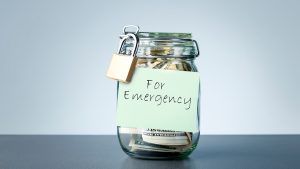Investment and saving are both essential concepts of personal finance; however, they have different functions and yield different results. Saving is the process of saving money in a safe place, generally through a banking account, to meet short-term requirements or emergency situations. It puts safety and liquidity over growth. It does, however, involve utilizing your funds to purchase investments such as bonds, stocks, mutual funds, or real estate in the hopes of increasing the wealth of your family over time. They are riskier than savings, yet they also provide the possibility to earn better yields. Understanding how to balance both and understanding the differences between them is crucial for financial success. sense.
Why Saving Is Usually the First Step
For the majority of people, saving is the very first financial habit to develop because it provides a financial cushion. Life isn’t always predictable, and unexpected expenses could arise anytime. It doesn’t matter if it’s medical emergencies or car repair or the loss of a job; having money in a savings account will allow you to handle the situation without going into debt. Experts recommend having an emergency fund that has enough money for three to six months of expenses. Store the fund in a secure and easily accessible savings bank account. Without this security in place, investing may not be the best option because market prices can fluctuate and may not be accessible when you need them.
The Role of Saving in Your Financial Plan
Savings are a crucial element in any financial plan that is sound. Alongside the emergency fund, savings can be ideal for short-term goals such as purchasing a new smartphone, taking a trip, or putting down an amount on a car. Because these goals typically fall within a period of one to five years It is safer to store the funds in the savings account or certificates of deposit. Saving can also teach discipline, increase the confidence to manage money, and ease the stress of financial planning. Once you’ve established a habit of saving consistently, it will lay the foundation to develop more sophisticated financial habits, such as investing.
When Investing Becomes the Smart Next Move
Once you have established your emergency savings and feel confident in managing your finances, investing becomes a logical next step. It is crucial to invest in order to build the long-term financial wealth you want and to prepare for more ambitious financial goals, like purchasing a home and funding college or even retirement comfortably. In contrast to savings accounts, which earn little interest, investments increase in value over time thanks to the potential of compounding. Beginning early gives your investment more time to expand and bounce back from volatility and downturns. Although investing is riskier than saving, it’s vital if you wish to ensure that your money keeps pace with inflation or even outpaces it and helps you live a better lifestyle in the future.
Balancing Safety and Growth in Your Financial Life
It is important to not think of savings and investing as two distinct alternatives but rather as complementary strategies. Each serves a distinct function and is a good fit for different aspects of your financial plan. Saving can provide assurance and access to cash, while investing can help your money grow and achieve longer-term goals. A balanced approach is the process of making a solid base of savings and gradually incorporating investments into your budget. The balance will ensure that you are able to meet short-term demands without sacrificing the long-term benefits. When your finances improve, you can alter the amount of your savings or invest, based on your objectives and risk-taking capacity.
Assessing Risk Tolerance Before You Invest
Investing is a process that involves taking on a degree of risk, and it is important to determine your own personal level of comfort with the risk prior to beginning. Every person has a different degree of risk tolerance, based on their circumstances, personalities, and objectives. If the thought of losing money quickly makes you sleepy in the night, then you might prefer a more prudent approach to investing. But staying away from investing altogether could be risky long-term since your savings might not increase enough to meet your future requirements. You can choose investments that match your risk tolerance and offer growth opportunities.
Adjusting Your Strategy as Your Life Changes
Your financial priorities and needs can evolve, and so it’s essential to periodically evaluate and modify your strategy for savings and investment. Events in life like marriage or children, job changes, or retirement can require you to shift your focus. As an example, you may raise your savings while preparing for a major purchase or adopt an aggressive approach to investing in the pursuit of long-term growth. Being open and flexible to changing circumstances will help you keep your goals in check no matter the challenges life throws at you. Financial planning isn’t a one-time thing but rather a continuous process that grows along with your needs.
Conclusion
Investment and saving are crucial elements of a successful financial plan, but deciding which one to concentrate on first is contingent on your personal circumstances, goals, and the level of risk you are comfortable with. In general, it’s best to begin by saving to create a security cover and to manage your short-term needs. Investing is essential to accumulating wealth and making plans for the near future once that foundation has been established. It’s not about choosing one over another but learning how to use each one wisely. By balancing the two and with a well-thought-out approach, you can establish an enduring and secure financial future that will support your long-term goals and lifestyle.
FAQs
1. Should I invest or save money if I’m just beginning?
If you’re only getting started on your financial journey, it’s recommended to start with saving, particularly for emergency needs and other short-term requirements. When your savings are steady, then you can start investing.
2. How much do I need to save before I invest?
A Manyxperts suggest keeping at least three or six months of your living expenses in an emergency fund before investing.
3. Can you invest and save simultaneously?
With a proper budget, it is possible to allocate a percentage of your earnings to saving and investing, based on your financial goals and stability.
4. Which one is riskier, saving or investing?
Saving is risk-free; however, it also offers lower returns. Investments carry more risk but can provide greater long-term growth.
5. What should I do if I want to invest money before establishing an emergency savings account?
Investing before establishing an emergency savings plan can be risky because unexpected expenses may force you to sell investments at a loss. It’s better to begin building funds first.




